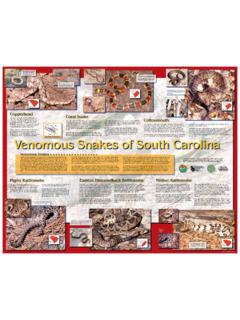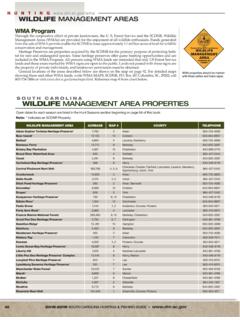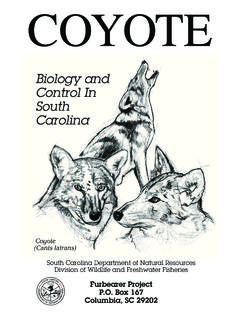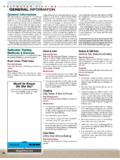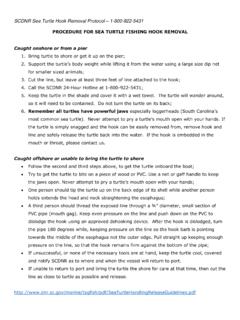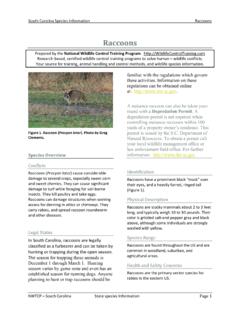Transcription of Armadillos - South Carolina Department of Natural …
1 South Carolina Species Information Armadillos NWCTP South Carolina State Species Information Page 1 Armadillos Prepared by the National Wildlife Control Training Program. Research-based, certified wildlife control training programs to solve human wildlife conflicts. One source for training, animal handling and control methods, and wildlife species information. Figure 1. Nine-banded armadillo (Dasypus novemcinctus). Photo by US Fish and Wildlife Service (USFWS). Species Overview Conflicts Armadillos can damage turf as they forage for insects and other invertebrates in the soil. Legal Status In South Carolina , there is no closed season on Armadillos on private lands statewide with a vaild hunting license.
2 Night hunting is permitted from the last day of February to July 1 as long as the South Carolina Department of Natural Resources (SCDNR) is notified. Contact the SCDNR for further restrictions. Identification Armadillos belong to a small group of mammals distantly related to anteaters and sloths. The word armadillo is Spanish for little armored one. Physical Description The nine-banded armadillo (Dasypus novemcinctus, Figure 1) has a protective armor of horny material on its head, body, and tail. The armor has nine movable rings between the shoulder and hip shield. The head is small with a long, narrow, pig-like snout. Canine and incisor teeth are absent. An armadillo has 7 to 9 peg-like teeth along the cheek on each side of the upper and lower jaw.
3 The long, tapering tail is encased in 12 bony rings. Armadillos weigh 8 to 17 pounds. Species Range Armadillos range from Texas to southeast New Mexico, through Oklahoma, southeast Kansas, southwest Missouri, Arkansas, and southwest Mississippi. Their range includes central Alabama, Georgia, and Florida, and has extended northward in recent times. Health and Safety Concerns Armadillos can be infected with Mycobacterium leprae, the causative agent of leprosy. Armadillos can carry Trypanosoma cruzi, the parasite responsible for Chagas disease. Avoid touching Armadillos with bare hands, and avoid contact with their blood and fluids. General Biology, Reproduction, and Behavior Reproduction Females produce one litter per year during March or April after 150 days of gestation.
4 Nesting/Denning Cover Armadillos usually dig burrows that are 7 or 8 inches in diameter and up to 15 feet in length. South Carolina Species Information Armadillos NWCTP South Carolina State Species Information Page 2 Armadillos often have several burrows in one area. Behavior Armadillos primarily are active from twilight through early morning in the summer. They avoid activity during extreme temperatures. Male Armadillos may be more active during mating season. Habitat Armadillos prefer dense, shady cover, such as brush, woodlands, forests, and areas adjacent to creeks and rivers. Food Habits More than 90% of their diet consists of insects, especially larvae.
5 They also feed on earthworms, scorpions, spiders, and other invertebrates, including maggots and pupae in carrion. Armadillos eat fruits and vegetables, such as berries and roots. They will eat lizards, small frogs, snakes , and the eggs of upland birds. Voice, Sounds, Tracks, and Signs Armadillos make low grunting sounds when feeding or when mothers call their young. Damage to Landscapes Armadillos uproot flowers and other ornamental plants. Damage to turf can be extensive and can be difficult to distinguish from damage by raccoons (Figure 2). Figure 2. Damage to turf by Armadillos . Photo by Ron Fry. Damage to Crops and Livestock Armadillos are not considered a threat to crops or livestock.
6 Damage to Structures Armadillos burrow under foundations, concrete slabs, driveways, pools, and other structures. Damage Prevention and Control Methods Habitat Modification Armadillos prefer to dig burrows in areas with cover. Remove brush to discourage Armadillos from becoming established. Exclusion Fences or barriers may exclude Armadillos under certain conditions. Bury the fence 12 to 18 inches (deeper for sandy soil) and extend it at least 3 feet high. Frightening Devices None are known to be effective on Armadillos . Repellents None are known to effectively repel Armadillos . Toxicants None are registered for use on Armadillos . South Carolina Species Information Armadillos NWCTP South Carolina State Species Information Page 3 Shooting There is no closed season on Armadillos with a valid hunting license on private lands.
7 Armadillos that cause damage may be shot where it is legal to discharge a firearm. Recommended firearms are a shotgun with No. 4 to BB-sized shot, or a .22-caliber rifle. Trapping In South Carolina , the armadillo can be trapped and dispatched on site. It is illegal to transport and release to a new location. We recommend the use of live traps and suggest checking the legality of moving the animal to another location. Armadillos can be captured in single-door cage or box traps (10 x 12 x 32 inches) and 2-door cage or box traps (10 x 12 x 48 inches). Only use traps that are professionally manufactured when trapping Armadillos as Armadillos can destroy traps that are poorly constructed.
8 Set traps along pathways to burrows and along fences or other barriers where Armadillos may travel. Increase effectiveness of traps by using wings of 1- x 4-inch or 1- x 6-inch boards 6 feet long, which help funnel the animal into the trap (Figure 3). Sets such as those shown in Figure 3 do not need baiting. If bait is desired, use spoiled fruit, rotten meat, or mealworms. The use of bait provides no added advantage over using traps with wings in blind sets. Figure 3. Wings situated on a two-door cage trap. Photo by Tomahawk Live Trap Co. Armadillos may finish feeding before you begin trapping if a lawn is less than a acre. Ask the client how long the damage has occurred. If it was more than a day before you arrived, trapping may not be effective.
9 Disposition Relocation Relocation of Armadillos in South Carolina is not permitted. Translocation Translocation of Armadillos in South Carolina is not permitted. Euthanasia Carbon dioxide is effective for euthanizing Armadillos . Resources Web Resources South Carolina Species Information Armadillos NWCTP South Carolina State Species Information Page 4 Prepared by the National Wildlife Control Training Program. Research-based, certified wildlife control training programs to solve human wildlife conflicts. One source for training, animal handling and control methods, and wildlife species information.
